How natural gas can increase the sources of octane
Natural gas normally gets a great deal of attention as a feedstock for power generation: As the U.S. makes the gradual transition from coal, natural gas has taken center stage in the spotlight because it burns more cleanly than coal. As such it’s already being credited with helping the country raise its gross-domestic product by 28 percent since 2000, while reducing carbon emissions by 6 percent.
But power generation is only part of the story with NG. It can also be used to make liquid alcohol fuels like ethanol, helping the U.S. continue on the path pioneered by corn-based ethanol. Ethanol, regardless of how it’s made, is cleaner and cheaper than gasoline, and can run millions of passenger vehicles in the U.S.
As part of Fuel Freedom’s efforts to educate the public about the benefits of high-octane alcohol fuels, we’re introducing the possibility of natural gas as an additional resource. We’ve created a handy infographic that outlines the challenges and the solution.
There’s a lot going on with this piece of artwork, so we’ll describe it in six easy pieces:
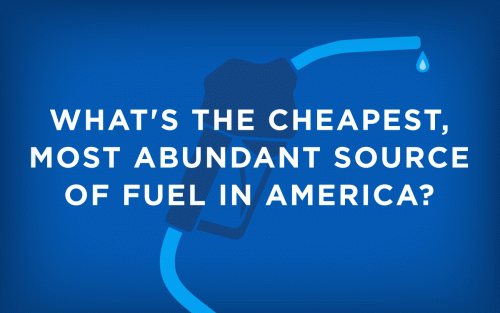
You guessed it: natural gas! As we pointed out in an op-ed in the Financial Times, the shale revolution has more to do with natural gas than oil. Wells in shale-rock formations bring up more hydrocarbons in the form of NG and NG liquids than crude.
Right now we’re awash with natural gas. Despite continuing to generate more and more of the electricity our country uses each year, we have more natural gas than we know what do with. Even without adjusting for inflation, natural gas is selling at its lowest price since 1998. There’s simply far more supply than there is demand.
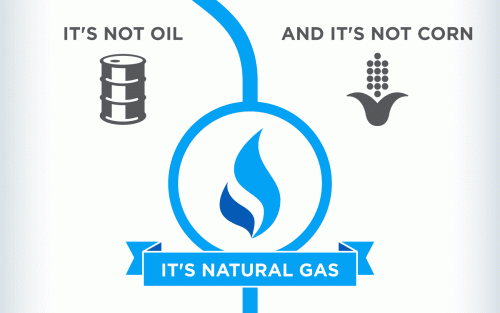
The U.S. Energy Information Administration expects NG to average $2.18 per million British Thermal Units during 2016; an equivalent amount of oil fetches about $9. During a discussion at the Hudson Institute in D.C. earlier this month, we noted that the price discount NG enjoys comparative to oil is expected to keep widening for the next two decades.
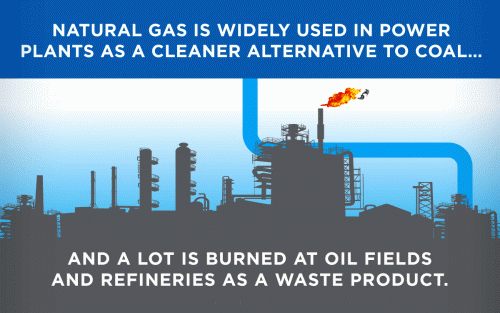
The U.S. has enough reserves of dry natural gas in the ground to last for decades. But because power generation is the most dominant use for NG, and the changeover from coal-fired plants to NG-fired ones is painstaking and expensive, there’s little market for NG. That’s one reason why gas is so cheap right now.
Since the market is so unprofitable, the United States is literally burning off billions of dollars worth of natural gas into the atmosphere via flaring, contributing to climate change and depriving tax revenue to local governments.
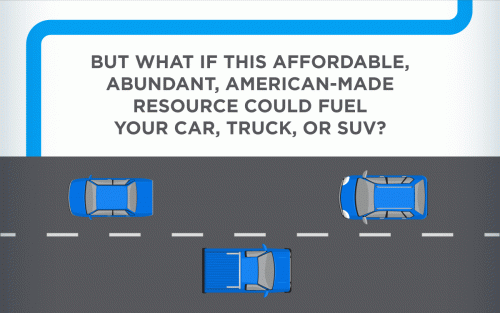
The U.S currently consumes about 18 million barrels of crude a day, most of that devoted to transportation use. And yet we must import 7 million barrels, because we can never drill enough oil to meet domestic demand. We should be using more of the abundant, cheap natural gas trapped beneath the ground to satisfy our transportation needs. And we don’t just mean as compressed natural gas (CNG) or liquefied natural gas (LNG), which is already used in big vehicles like city buses and garbage trucks. That’s a limited market.
The big prize is the 250 light-duty vehicles (cars, pickups, SUVs and crossovers) on the road in the United States. All of them can run on some level of ethanol (regular gas contains 10 percent of it). Some 21 million light-duty vehicles are flex-fuel vehicles, able to run on any mixture of gasoline and ethanol, up to 85 percent ethanol (E85).
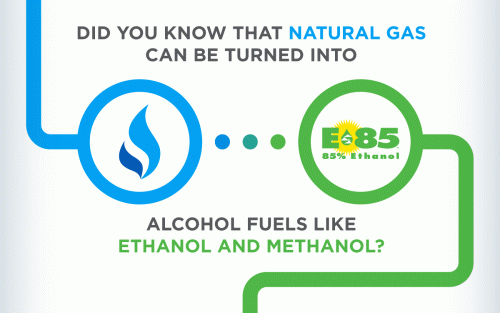
According to Fuel Freedom-supported research conducted by the University of Colorado’s Miles Light, making NG-based ethanol available would build upon the price gains consumers already have enjoyed with corn-based ethanol:
Low cost ethanol and methanol is made possible by a new enzyme and chemical technologies that convert natural gas into pure ethanol According to Coskata and Celanese corporations, the marginal cost of ethanol is reported to be $1.25 (Coskata) to $2.35 (Celanese) per gallon, when natural gas feedstocks are $4.00 per million British Thermal Units (mmbtu). When blended to create (E85), a common fuel mix consisting of 85 percent ethanol and 15 percent gasoline, the net cost would be approximately $1.65 per gallon (if the ethanol cost is $1.50).

The technology for turning natural gas into ethanol already exists.
Using more domestically produced natural gas for high-octane ethanol as a transportation fuel would provide a variety of benefits to the American public: It would reduce the price we pay at the pump; it would lessen our dependence on oil, reducing the influence and power of oil-exporting nations and strengthening our national security; it would provide further reductions in greenhouse-gas emissions like CO2; and it would cut tailpipe emissions that form smog and worsen health problems like asthma and heart disease.
Here’s the full infographic, suitable for sharing, publicizing, using as a debate tool with your friends. Tell us what you think, and join the fight!
Related posts:
- How natural gas could become a mainstream transportation fuel
- Low prices, abundance make NG a viable fuel, FFF says at Hudson
- U.S. vehicle fleet needs to plug in to shale-gas glut
- NG touted as the next ‘alternative fuel’ at San Diego conference
- Giuliani: Americans will embrace the ‘shale revolution’


Sorry. It’s not worth poisoning millions upon millions or gallons of water.